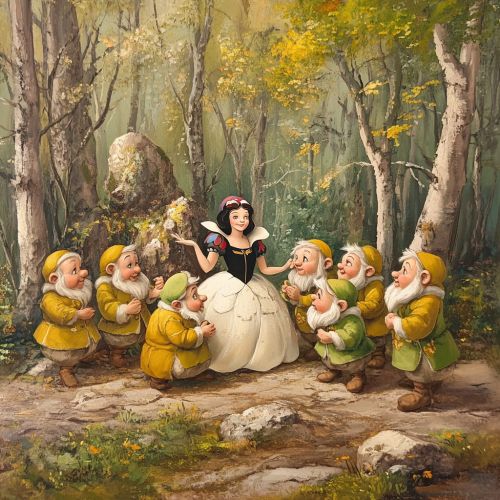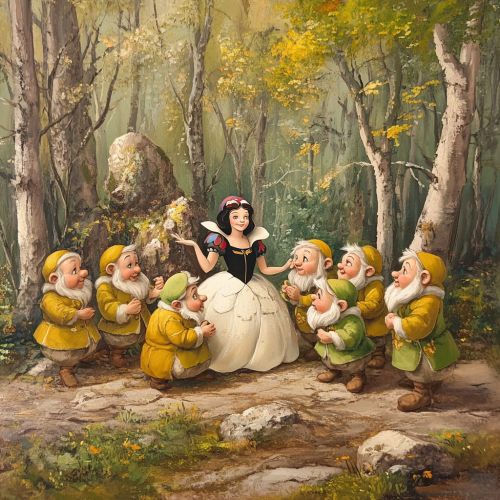Disney Animated Canon: Difference between revisions
(Created page with "== Overview == The '''Disney Animated Canon''' refers to the series of animated feature films produced by Walt Disney Animation Studios, which is the flagship animation studio of The Walt Disney Company. This canon encompasses a wide range of animated films that have been released from the studio's inception in 1937 with "Snow White and the Seven Dwarfs" to the present day. The Disney Animated Canon is distinguished from other Disney animated works such as direc...") |
No edit summary |
||
| Line 9: | Line 9: | ||
The Disney Animated Canon began with the release of "Snow White and the Seven Dwarfs" in 1937, which was the first full-length cel-animated feature in motion picture history. This film set the standard for future animated films and established Disney as a leader in the animation industry. Following the success of "Snow White," Disney released several other classics during this period, including "Pinocchio" (1940), "Fantasia" (1940), "Dumbo" (1941), and "Bambi" (1942). | The Disney Animated Canon began with the release of "Snow White and the Seven Dwarfs" in 1937, which was the first full-length cel-animated feature in motion picture history. This film set the standard for future animated films and established Disney as a leader in the animation industry. Following the success of "Snow White," Disney released several other classics during this period, including "Pinocchio" (1940), "Fantasia" (1940), "Dumbo" (1941), and "Bambi" (1942). | ||
[[Image:Detail-97495.jpg|thumb|center|Illustration of Snow White with the Seven Dwarfs in a forest setting.|class=only_on_mobile]] | |||
[[Image:Detail-97496.jpg|thumb|center|Illustration of Snow White with the Seven Dwarfs in a forest setting.|class=only_on_desktop]] | |||
=== Wartime and Post-War Era (1940s-1950s) === | === Wartime and Post-War Era (1940s-1950s) === | ||
Latest revision as of 17:06, 5 August 2024
Overview
The Disney Animated Canon refers to the series of animated feature films produced by Walt Disney Animation Studios, which is the flagship animation studio of The Walt Disney Company. This canon encompasses a wide range of animated films that have been released from the studio's inception in 1937 with "Snow White and the Seven Dwarfs" to the present day. The Disney Animated Canon is distinguished from other Disney animated works such as direct-to-video sequels, television series, or films produced by other Disney-owned studios like Pixar.
Historical Development
Early Years (1937-1949)
The Disney Animated Canon began with the release of "Snow White and the Seven Dwarfs" in 1937, which was the first full-length cel-animated feature in motion picture history. This film set the standard for future animated films and established Disney as a leader in the animation industry. Following the success of "Snow White," Disney released several other classics during this period, including "Pinocchio" (1940), "Fantasia" (1940), "Dumbo" (1941), and "Bambi" (1942).


Wartime and Post-War Era (1940s-1950s)
During World War II, the studio faced financial difficulties and a shortage of staff, which led to the production of package films such as "Saludos Amigos" (1942) and "The Three Caballeros" (1944). These films were collections of shorter segments rather than a single narrative. The post-war era saw a return to feature-length narratives with the release of "Cinderella" (1950), "Alice in Wonderland" (1951), and "Peter Pan" (1953).
Silver Age (1950s-1960s)
The Silver Age of Disney animation is marked by the release of several critically acclaimed and commercially successful films. This period includes "Lady and the Tramp" (1955), "Sleeping Beauty" (1959), and "101 Dalmatians" (1961). The use of Xerography in "101 Dalmatians" revolutionized the animation process by allowing animators to transfer drawings directly onto cels, reducing production costs and time.
Decline and Renaissance (1970s-1990s)
The 1970s and early 1980s are often considered a period of decline for Disney animation, with films like "The Aristocats" (1970), "Robin Hood" (1973), and "The Black Cauldron" (1985) receiving mixed reviews. However, the late 1980s and 1990s saw a resurgence known as the Disney Renaissance. This era began with "The Little Mermaid" (1989) and continued with hits such as "Beauty and the Beast" (1991), "Aladdin" (1992), and "The Lion King" (1994).
Post-Renaissance and Revival (2000s-Present)
The early 2000s were a transitional period for Disney animation, with films like "Atlantis: The Lost Empire" (2001) and "Treasure Planet" (2002) experimenting with different styles and technologies. The acquisition of Pixar in 2006 and the success of "The Princess and the Frog" (2009) marked the beginning of a new revival. Recent films such as "Frozen" (2013), "Moana" (2016), and "Raya and the Last Dragon" (2021) have continued to build on Disney's legacy of innovation and storytelling.
Technological Innovations
Disney has been at the forefront of animation technology since its inception. The studio pioneered the use of the Multiplane Camera, which added depth to animated scenes, and was first used in "Snow White and the Seven Dwarfs." The introduction of Xerography in the 1960s allowed for more efficient production processes. In the 1990s, Disney embraced Computer-Generated Imagery (CGI) with films like "Tarzan" (1999), which used a technique called Deep Canvas to create 3D backgrounds.
Artistic and Cultural Impact
The Disney Animated Canon has had a profound impact on both the animation industry and popular culture. Disney's storytelling techniques, character development, and musical compositions have set benchmarks for animated films. The studio's portrayal of fairy tales, folklore, and original stories has influenced generations of audiences and filmmakers. Disney's commitment to diversity and inclusion is evident in recent films that feature characters from various cultural backgrounds and address contemporary social issues.
Critical Reception and Awards
Disney animated films have received numerous awards and accolades over the years. "Beauty and the Beast" was the first animated film to be nominated for the Academy Award for Best Picture. Several Disney films have won the Academy Award for Best Animated Feature, including "Frozen," "Big Hero 6" (2014), and "Zootopia" (2016). The studio's films are also frequently recognized for their musical scores and songs, with composers like Alan Menken and Howard Ashman contributing to Disney's success.
List of Films in the Disney Animated Canon
The Disney Animated Canon currently consists of 61 films, starting with "Snow White and the Seven Dwarfs" and including the most recent release, "Raya and the Last Dragon." This list includes both traditionally animated and CGI films, reflecting the studio's evolution over the decades.
